How Important is Chinese Lending to Latin America?
Chinese lending to Latin America and the Caribbean hit an all-time high of $37 billion in 2010.
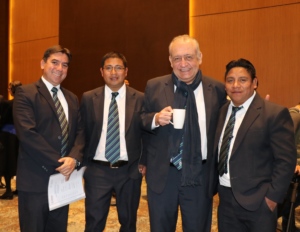
The Opportunities for My Community project promotes development in Guatemala by linking remittances with development, formalizing savings and investing in education in order to build human and economic capital.
The project has four key components:
The project works hand-in-hand with local financial institutions, schools, and migrant groups to strengthen economic growth and social development, providing the resources and tools necessary to strengthen Guatemala’s “human capital.”[1]
These partners understand Guatemala’s development needs and, in coordination with the project, support the implementation of the mentioned components in a number of different ways. In the process, they take ownership of the project in a positive way, thereby contributing to the sustainability of the work and its impact.
Partnerships are one of the most important vehicles for projects that link migration and development.[2] Successful alliances, those that promote impactful and sustainable results, are formal and operational. It is possible to measure the strength of alliances through three key criteria:
These criteria can also be used to promote partnerships in terms of project implementation. Additionally, strong partnerships lead to other positive outcomes. For example, they strengthen sustainability and allow for accountability among partners. They also promote working together towards common goals.
It is possible to observe strong alliances within the Opportunities for My Community project. In each of the four components of the project, diverse partners are involved, sharing risk, contributing resources, and building social capital.
One of the primary objectives of the project is to coordinate efforts with local organizations in order to satisfy the financial and educational needs of participating communities in Guatemala’s Western Highlands and in its capital city, Guatemala City. Thanks to this close level of coordination, the project has been able to establish solid partnerships, encourage participation, and guarantee successful outcomes.
Project partnerships are presented below by component, with specific examples of how partners invest resources, take ownership of project objectives and share risks, as well as how they show transparency, trust, and teamwork.
As part of its financial education strategy, the project works with three leading financial institutions in Guatemala: the MICOOPE credit union system, Banco Industrial (BI), and the Banco de Desarrollo Rural (Banrural).

Each institution provides 10 agencies that are assigned a financial educator trained under the methodology of the project, who provides personalized financial advising sessions to remittance recipients and other transactional clients. The financial advising motivates them to formalize their savings, thus contributing to financial inclusion in each of the communities.
These financial institutions have provided financial educators with physical work space, furniture to perform their job, as well as uniforms, technological equipment, and continuous trainings. It’s estimated that, for each educator, the banks and cooperatives invest an average of $890, which translates to an estimated $26,700 investment for the 30 educators.
In addition, Banrural covers the salaries of two of financial educators, contributing a monthly salary and benefits totaling approximately $695 per educator. Likewise, Banrural provides their employees a bonus in December, which has been extended to the financial educators of the project, amounting to close to $425 per educator.
Along with MICOOPE, BI and Banrural are key partners in the credit component. The project assigns a business specialist that provides technical support to small businesses to strengthen their business practices, while the banks and cooperatives evaluate the credit requests of these businesses and grant the loans with resources from their own credit portfolio.
Graphic 1. Strategy for Supporting Knowledge Economy Businesses
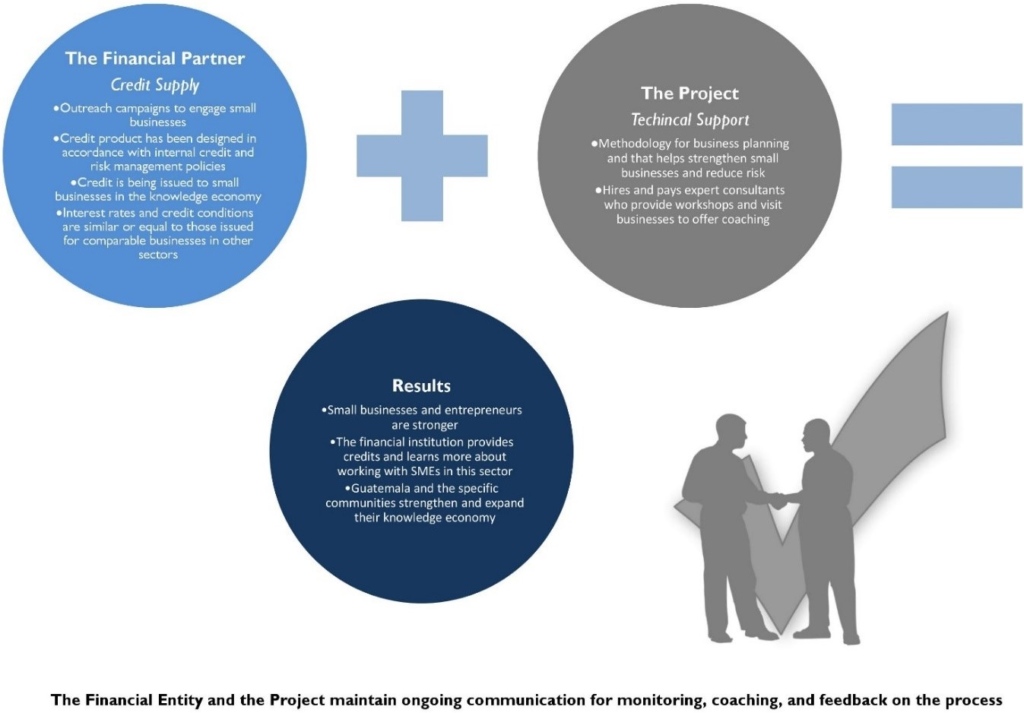
Determining the eligibility and conditions of credit is the responsibility of the financial institutions. Their credit counselors invest time and resources in locating and evaluating clients according to their potential to participate in the knowledge economy through the implementation of information, technology or education in their production or service processes.
As of March 2018, these institutions have made available a credit portfolio of more than $85,000 for the project, providing 50 credits with an average value of $4,500. Though the repayment process is going smoothly, it is important to note that the financial risk for these small credits is assumed by the financial institutions.
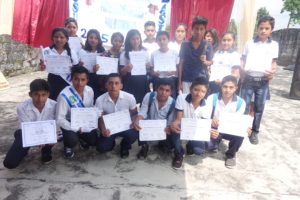
Two diaspora groups have partnered with the project to help strengthen education in Guatemala. They have recommended teachers that voluntarily donate their time and knowledge to teach an extracurricular program in migrants’ hometowns. United for El Palmar (Unidos por El Palmar) works in El Palmar, Quetzaltenango; while the Association of Caterinecos Migrants (Asociación de Migrantes Catarinecos) work in Santa Catarina Mita, Jutiapa. Meanwhile, the project assumes responsibility for training, technical support, and pedagogical help to ensure the quality of the extracurricular classes.
The diaspora groups are responsible for coordinating the implementation of the project in their communities, including negotiating the physical classroom space, promoting the enrollment of students, and managing relations with local education authorities.
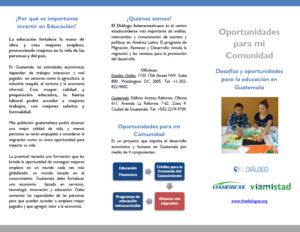
This component also engages remittance companies in educational efforts in Guatemala. The remittance company VIAMERICAS has distributed, via their network of service locations in the United States, more than 15,000 brochures that raise awareness about educational needs in Guatemala. Through these brochures, migrants learn more about educational issues and are motivated to invest in education in their country of origin.
In addition, the project aims to build on the engagement of remittance companies through an agreement with INTERMEX, bringing an educational program La Nueva Concepcion, Escuintla, in partnership with the Guatemalan diaspora group Red Migrante.

At the start of the respective 2017 and 2018 school years, the project approached the Ministry of Education of Guatemala to explain the project and seek authorization from regional educational authorities in the departments of Quetzaltenango, Huehuetenango, and Totonicapán.
Thanks to the support of educational authorities and local schools, 24 educational centers in the Guatemala’s Western Highlands opened their doors to the education program, which develops skills and knowledge that young people need as they prepare to enter the labor market in an increasingly globalized and competitive world.
The principals of these schools have provided classroom space for the extracurricular educational program at little to no cost. Thanks in large part to their support, the extracurricular program has enrolled more than 5,000 students in two years.
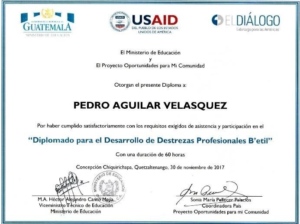
Likewise, the school principals have provided space, time and support for graduation ceremonies that are attended by students, parents, and municipal educational authorities.
The Ministry of Education has demonstrated their support by providing the signature and seal of the Technical Vice Minister of Education on diplomas that are awarded to students who complete the entire program.
The cases described above show how partnerships are key to the successful implementation of the Opportunities for My Community project. The project’s four components, which share a common link with remittances and development, would not be possible without the support of partners.
Therefore, partner engagement and ownership over the project is key to promoting financial inclusion and education in Guatemala, while at the same time ensuring the sustainability the approach.
Annex 1. Partner Engagement: Criteria and Components
|
Components and Criteria |
Financial Education |
Credit for the Knowledge Economy |
Diaspora Engagement |
Extracurricular Education |
|
Shared |
-Image and visibility: Financial education brochures have the partners’ logos -Image and visibility: Uniforms and/or badges have partners’ logos |
-The financial risk of the portfolio is assumed exclusively by the partners |
-Image and visibility: Student certificates with the logos of the diaspora groups -Image and visibility: Informational brochures distributed in the United States with logos of the remittance company |
-Image and visibility: Student certificates with the logos of the Institutions -Image and visibility: Diplomas with the logo of the Ministry of Education |
|
Resource Commitment |
-Investment in training, furniture, and equipment -Banrural assumes two salaries and all bonuses for Financial Educators |
– Loan evaluation specialists from partner institutions map potential participants -The credits issued come from the partners’ credit portfolio |
-Donation of time and knowledge by the volunteer teachers -The diaspora groups are responsible for negotiating physical classroom space |
-Schools provide resources: physical space, services (electricity, water, etc.) -Schools help arrange graduation ceremonies |
|
Confidence (Openness, transparency, and information sharing) |
-As of March15, 2018 85,817 financial advising sessions have been provided. Of these, nearly a quarter of participants have gone on to formalize or increase their savings, or have acquired a financial product -Progress reports are shared periodically among the partners and the project -Workshops are provided to share project methodologies with partners |
-50 credits with each averaging $4,500 -Project reports are shared periodically among the partners and the project – Workshops are provided to share project methodologies with partners
|
-Signed agreements with 3 diaspora groups and 1 remittance company for educational improvement -Over 600 students enrolled in the Diploma in 2017 and 2018 -6 teachers participating in the Diploma -Some shared resources |
-3 authorizations from Departmental Direction of the MINEDUC -Schools support and promote enrollment, allowing the project to reach more than 5,000 students -School principals sign certificates for the students -Vice Minister of Technical Education signs Diplomas for the students |
Chinese lending to Latin America and the Caribbean hit an all-time high of $37 billion in 2010.
Venezuelan president Nicolas Maduro left China last month with a supposed show of support from the Chinese government.
Summary of PREAL’s recent international conference on teacher effectiveness, held in Guatemala City.
